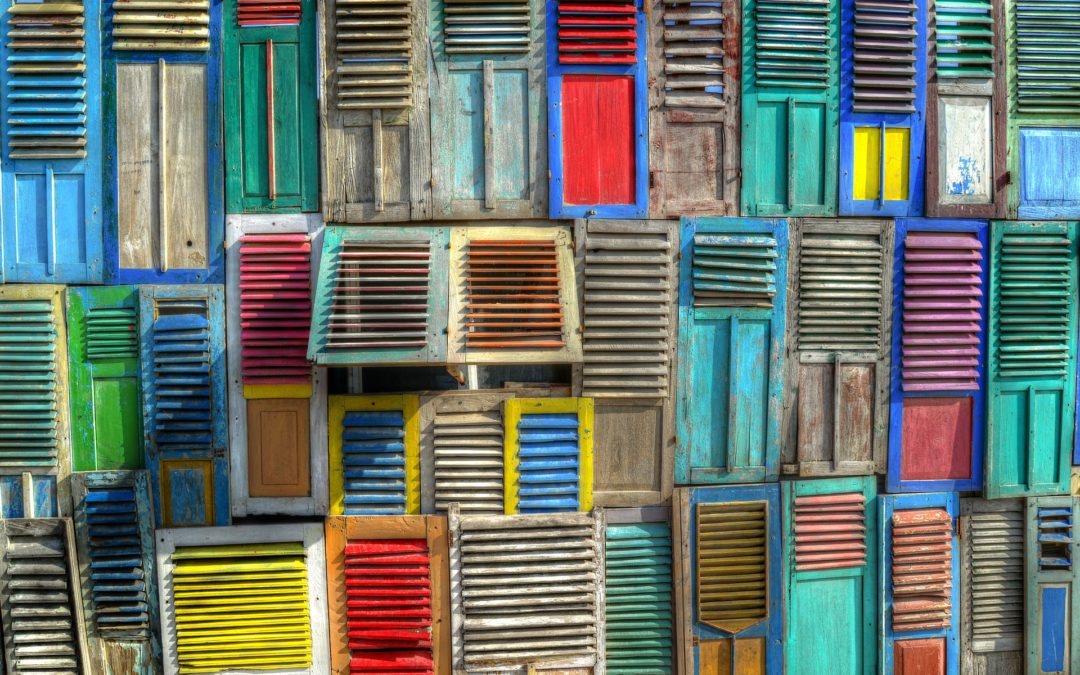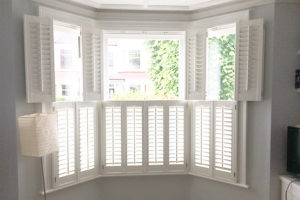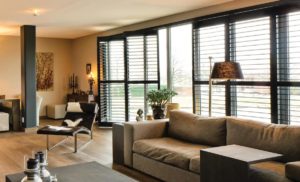Is there a perfect window treatment?
That depends on your definition of perfect. But we think that shutters are pretty darn close.
No, they weren’t invented in France
Even though they represent the quintessential French café scene they were invented in England almost 500 years ago. During that period they were solid boards designed to be opened to let in fresh air and they only covered the unglazed (brrrr) lower half of the window because glass was expensive and difficult to find.
Shutter Styles
Full height shutters cover your whole window, top to bottom and open and close as one panel.
Tier on tier where the top and bottom half of your shutters are separate so you can open and close them independently.
Café style shutters which just cover the bottom half of your window.
Most shutters are slatted/louvered, but are also available solid or half solid (see full height shutter image above). Choosing your shutter style comes down to a matter of personal taste as they’ll suit every room and can fit all window shapes.
Traditional shutters are made with smaller slats, but these days the ‘plantation shutter’ has become the norm, with its’ wider slats that let in more light and better views. 2 ½ ” slats/louvers are a popular choice but if you have a home with soaring ceilings and expansive views you may want to opt for larger slats of 3 ½ ”.
Interior or Exterior?
Functional shutters (not the decorative fixed panels) are found all around Europe on the exterior of the buildings rather than the interior, especially in the hotter countries. This practical choice is due to the fact that when situated on the window’s exterior they prevent hot rays of sunshine from penetrating through the windows and heating things up inside. In hot places or windows that receive alot of sun you want to keep the rays and their heat outside. This is even useful out here on the west coast with the increasingly hot summers that we’ve been experiencing.
On the exterior, wood shutters will weather the seasons well and they won’t peel or rot. Vinyl shutters may warp in direct sunlight over time and added paint may not stay on them as long. Aluminum are sturdy and will stand the test of time.
Exterior shutters will also help keep your windows safer in severe weather conditions on homes that are exposed such as on the waterfront or hillside locations.
What are they made from?
Shutters are manufactured in a few different materials and as with everything else there are pros and cons to each one.
Wood
- elegant and timeless
- available in many different species of natural wood (look for sustainably sourced)
- a wide range of stain or paint colors
- can be custom fit to most window styles
- has a unique look and feel that can’t be matched
- higher priced
- durable and built to last
Polyvinyl
- waterproof (think kitchens and bathrooms)
- can be custom fit to most window style
- limited in their range of colors
- least expensive
Aluminum
- mostly limited to exterior use
- excellent weather-resistance
- expensive
Which rooms will shutters work in?
Indoor shutters are very versatile and make a great addition to each and every room in the house. They work just as well in a formal dining room as they do in the kitchen. You can dress them up in a penthouse apartment or keep them casual in a beachfront cottage.
In bedrooms you may want to consider a solid shutter for their increased noise reduction, room-darkening properties, and privacy.
In an office it’s important to be able to control the amount of light coming in to avoid glare on a computer screen.
In dining rooms they will add a sense of drama and elegance and may cost less than custom draperies.
In a living room you may want to preserve a great view through a picture window while simultaneously controlling light and heat.
In bathrooms they are great for privacy and ambience.
P.S. Miss M’s favorite part of exterior shutters is the connection to the outdoors when you open your windows to open or close them. It’s wonderful for taking a quick breath of fresh air upon waking or just before bed and physically feeling the weather.
Nothing is perfect
Keep in mind that interior shutters will be more accessible than exterior mounted ones as you won’t have to lean out the window to close them. The bar that adjusts the position of the slats may be difficult to grasp for those with mobility issues, but with custom made shutters the manufacturer may be able to change that with a bigger bar or change of location.
Action Plan
If you’ve been on the fence about your window treatments take a closer look at shutters, they may be your ‘almost’ perfect solution…







